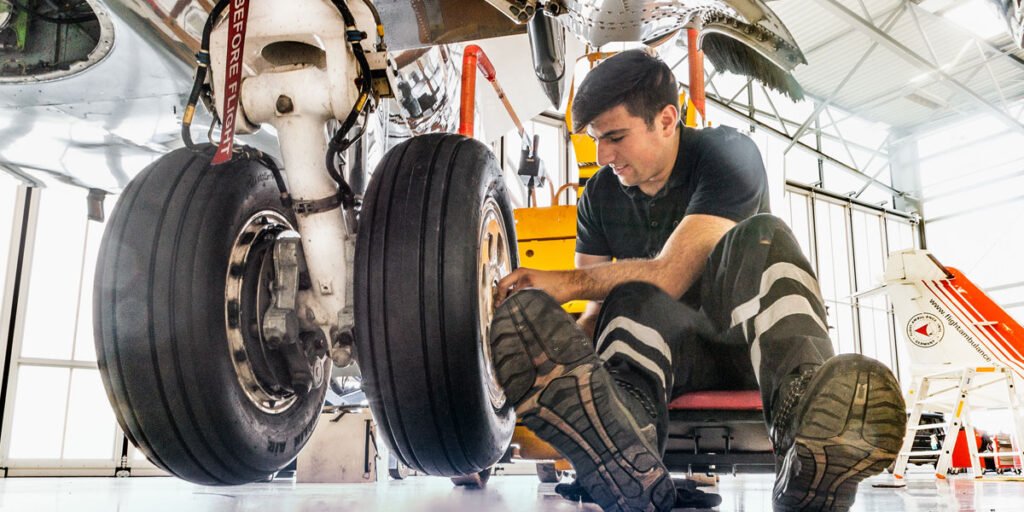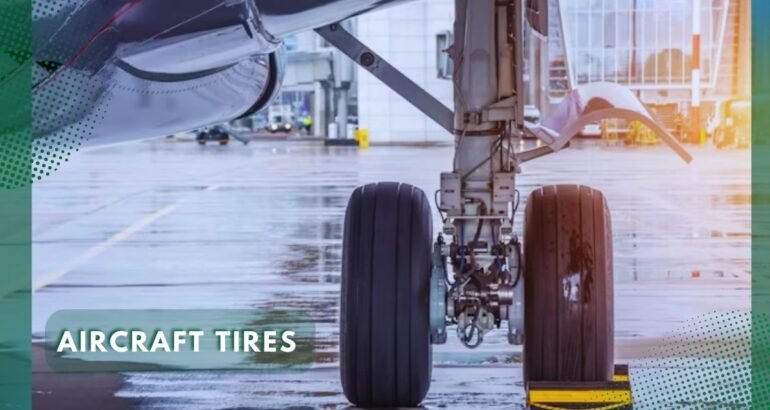Aircraft tires represent a fundamental yet often overlooked aspect of aviation technology. Meemsdxb is with you to explain these highly specialized components in maintaining aviation safety and operational efficiency.
The purpose of this article is to deeply examine aircraft tires, their structural compositions, the factors that determine their performance, and their environmental consequences.
Having valuable insight into the supply of aircraft parts is one of the most valuable insights you need in this industry.
We will be with you so that by checking the establishment of relationships with reliable suppliers, you will be able to carry out full quality evaluations and perform a basic assessment of reliability and compliance. Stay with the “Aircraft Tires” article.
Understanding Aircraft Tires
Airplane tires are not simple rubber tires. They are designed in such a way that they can show good resistance against the harshest air environments and bear the heavy weight of commercial and military aircraft.
However, they require a combination of layers of flexible rubber, strong fabric reinforcements, and strong steel belts.
It is important to know that maintaining proper tire pressure is a vital responsibility. By carefully monitoring and adhering to recommended pressure levels, aviation professionals can achieve the following:
It was ensured that the performance of the tires was protected.
Received safety on take off.
Maximize the stressful landing and operations experienced by passengers during the flight.
Factors Affecting Aircraft Tire Performance
Environmental variables such as temperature and altitude can be effective factors on the performance of airplane tires because extreme cold or heat has significant effects on tire pressure and tension and brings potential safety hazards that require careful consideration.
These items are the frequency of landing and takeoff cycles and should not be ignored because ignoring them will cause tire wear and tear. By carefully monitoring these factors, aviation professionals can proactively access:
Reduce risks
Increase tire life
Compliance with optimal safety standards

Technological Advancements in Aircraft Tires
In recent years, Technological Advancements in Aircraft Tires have accelerated significantly in aircraft tire technology. By having and implementing innovation in tire design and materials, you can lead to improved durability and because of that, you can examine resistance to heat and overall performance.
These advancements and innovations can make a significant leap forward and strengthen safety standards and operational efficiency throughout the industry. Aviation professionals can reap the benefits of increased tire reliability, longer life, and reduced maintenance needs when they keep pace with today’s innovations.
Safety Considerations for Aircraft Tires
When it comes to Safety Considerations for Aircraft Tires, aircraft tires should be considered as the most vital part, and serious care should be taken for them.
The vital importance of regular inspection and maintenance shows that the tires are in perfect health and their very disastrous consequences are avoided. As a solution, we recommend doing the following:
Strict protocols and quality control measures must be implemented regularly and rigorously throughout the supply chain.
Build strong relationships with trusted suppliers and consider choosing a group of people to work with who prioritize quality, safety, and compliance.
This way, you will get a valuable strategy to get original and approved parts.
Complete qualitative assessments.
Get the necessary certificates.

Environmental Impact of Aircraft Tires
While aircraft tires are designed to withstand harsh conditions, their environmental impact also requires attention. It is very important to observe this point so that you can be useful in recycling and properly disposing of used tires to reduce possible damage to the environment.
Realizing this, the aviation industry continues to invest in sustainable solutions with no real goal other than to develop materials and minimize the tire’s environmental footprint.
By embracing these initiatives, aviation professionals can also benefit from:
Maintain safety.
Operational efficiency.
Industry collaboration, awareness campaigns, and stakeholder education on responsible tire disposal practices.
By prioritizing environmental awareness, the aviation industry can pave the way for a future where safety and sustainability coexist in the skies.
Future Trends in Aircraft Tire Technology
The future of aircraft tire technology is full of exciting possibilities. The following emerging technologies are poised to revolutionize tire performance monitoring and management. As:
Artificial intelligence.
Predictive maintenance systems.
The introduced systems can intelligently use large amounts of data to predict and analyze possible tire problems, as well as enable preventive maintenance.
These systems keep pace with advances in science are always up-to-date and may well offer materials that have great potential for lighter, more durable, and more environmentally friendly tire solutions.
Due to the aviation industry’s acceptance of being up-to-date, shareholders are encouraged to stay up-to-date with Aircraft Tire Technology through artificial intelligence and cooperate with the best tire manufacturers. This way, they make a great investment and ensure they stay at the forefront.
The Economic Impact of Aircraft Tire Maintenance
Proper maintenance of aircraft tires not only ensures safety but also has a significant economic impact. Regular inspections and maintenance help to identify potential issues early on, preventing costly tire failures during flight operations.
By investing in proactive tire maintenance, airlines can reduce downtime, increase operational efficiency, and minimize the risk of unexpected expenses related to tire replacements or repairs.
Additionally, well-maintained tires contribute to fuel efficiency, reducing overall operating costs for airlines.
The Economic Impact of Aircraft Tire Maintenance
Careful maintenance of aircraft tires has very high and significant benefits. In this way, it observes the safety issues and, after that, it also includes significant economic consequences. It is enough to take a preventive approach by planning for this industry and by maintaining the principles of tires, to bring the following to the aviation industry:
Protection from possible problems.
Reducing the risk of tire failure, which is very expensive.
Minimize downtime.
Increase operational efficiency.
Reducing unforeseen costs associated with tire replacement or repair.
Adopting comprehensive tire maintenance strategies enables airlines to streamline operational processes and strengthen their competitive advantage in the aviation industry.
The Role of Aircraft Tires in Flight Performance
Aircraft tires are an essential part of flight performance, primarily during takeoff and landing. The following can well explain why these basic components are necessary:
Tires bear the brunt of the enormous impact forces that occur when an aircraft hits the ground or accelerates for takeoff.
Tires facilitate effective braking by creating the necessary friction.
They help control direction during ground operations.
With proper edge conditions, tires have optimized maneuverability (on wet or icy tracks).
Note: Neglecting tire maintenance can:
Leading to reduced performance.
Creating longer braking distances.
Increased risk of hydroplaning.
To optimize operational efficiency and reduce possible risks, maintenance. Personnel must prioritize comprehensive tire maintenance strategies to meet safety standards.
The Challenges of Extreme Weather Conditions for Aircraft Tires
Extreme weather conditions present unique challenges for aircraft tires. Cold temperatures:
In cold temperatures, tires experience the following:
Rubber compounds harden
The flexibility and elasticity of tires decrease
Low temperatures:
In hot temperatures, tires experience the following:
Tire pressure increases.
In response to these weather-related factors, pilots and ground crews should prioritize safety and preparedness by following this list:
Complete pre-flight inspections.
Monitor tire pressure and temperature during an operation.
Prioritize following the manufacturer’s instructions for tire use and maintenance.
Invest in specialized tire technology (winter tires or high-altitude tires).
Online Aircraft Store
Online aircraft stores continue to evolve along with the aviation industry, and nowadays, they have emerged as a convenient and reliable solution for the supply of essential parts such as aircraft tires.
These specialized online platforms offer a wide range of quality tires that cater to different aircraft models and specifications.
By using online aircraft stores, pilots, aircraft owners, and maintenance professionals can easily benefit from the advantages of these stores:
Buy suitable tires from your surroundings (with a quick search and comparison).
Using efficient logistics.
Fast delivery of aircraft spare parts.
Access to comprehensive product information.
Get reviews from hundreds of customers.
FAQs:
Q: Can aircraft tires be repaired if damaged?
A: Generally not! Unless (in special cases) the tires of the aircraft have suffered minor damage.
Please note that not all damages can be repaired, and the final decision depends on the amount and nature of the damage.
After the tires are repaired by trained technicians, strict guidelines and regulations are followed to ensure that the repaired tires meet strict safety standards.
It is very important to pay attention to and check factors such as the following before repairing tires:
• Tire age
• Remaining tread depth
• Location and type of damage
Q: Can aircraft tires handle adverse weather conditions?
A: Aircraft tires are designed and manufactured to withstand a wide range of weather conditions, including adverse conditions.
However, extreme weather conditions (ice, snow, or extreme heat) can significantly challenge tire performance and longevity.
Cold temperature: hardening of rubber compounds
Reduced flexibility
Reduce tension
Hot air: leads to increased tire pressure
Possible cause of the explosion
Tip: Specialized tire technology, such as winter tires or high-temperature tires, can increase performance and safety in certain weather conditions.
Q: What are retreaded aircraft tires?
A: Retreaded aircraft tires refer to the process of renewing worn tires by replacing the worn tread with a new tread. This process includes the following:
• Removing the old tread.
• Inspect the tire cover for any damage.
• Applying a new layer of tread using specialized methods and materials.
Although retreading is a cost-effective and environmentally friendly alternative, it is important to note that not all aircraft tires can be retreaded, and decision-making factors should be considered, including the following:
• Tire age
• Body condition
• Constructive recommendations
Q: How are aircraft tires disposed of?
A: Aircraft tire disposal is carefully regulated to ensure environmental responsibility. When tires reach the end of their life or are deemed unrepairable, they should be disposed of properly by local laws and industry best practices. Including:
• Recycle
• Baking
• Energy recovery
• Environmentally safe disposal
Conclusion
Our effort from the meemsdxb article on aircraft tires is to consider it as an important aspect of the aviation technology industry. As you have been with us throughout the article, you must have noticed that the industry’s focus on safety, environmental responsibility, and innovation has and will continue to evolve aircraft tires.
As technology continues to advance, we can expect even more improvements in tire design, performance, and durability
Resources:
Aircraft Tire Wear Patterns and Causes” – AvBuyer
“The Future of Aircraft Tires: Advancements in Materials and Technology” – Aviation Today
Websites:
Aerospace Manufacturing and Design
Federal Aviation Administration (FAA)
Skybrary
Aviation Stack Exchange
AvBuyer
Aviation Today

One thought on “Aircraft Tires”